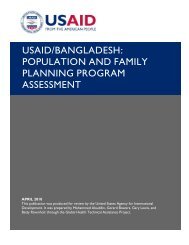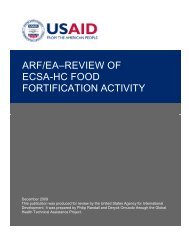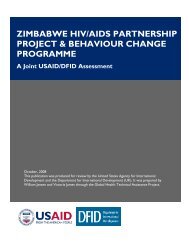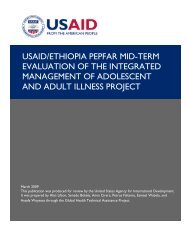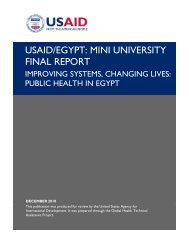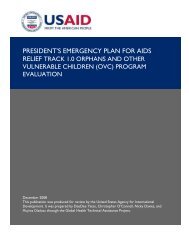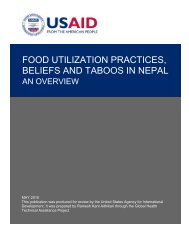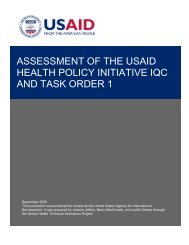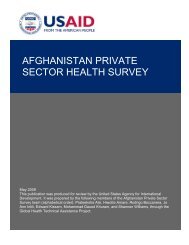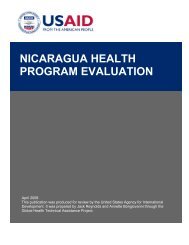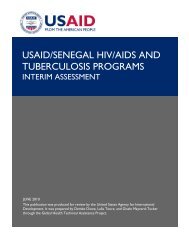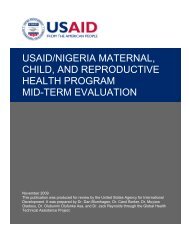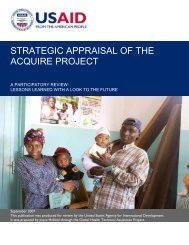Evaluation of the Tuberculosis Control Assistance Program (TB CAP)
Evaluation of the Tuberculosis Control Assistance Program (TB CAP)
Evaluation of the Tuberculosis Control Assistance Program (TB CAP)
Create successful ePaper yourself
Turn your PDF publications into a flip-book with our unique Google optimized e-Paper software.
focus is seen as being inconsistent with <strong>the</strong> goals <strong>of</strong> optimizing and linking <strong>TB</strong> <strong>CAP</strong> activities to nationalstrategic plans.Responding to Requests for Support<strong>TB</strong> <strong>CAP</strong> typically moves into a new country after <strong>the</strong> Mission, having consulted with USAID/Washington, makes a request for a <strong>TB</strong> <strong>CAP</strong> project. Upon learning <strong>of</strong> <strong>the</strong> Mission need, <strong>TB</strong> <strong>CAP</strong> selectsa partner to coordinate <strong>the</strong> <strong>TB</strong> <strong>CAP</strong> activity—a delicate process affected by such factors as <strong>the</strong> type andamount <strong>of</strong> support required and <strong>the</strong> technical capacity and interests <strong>of</strong> partners.The selection <strong>of</strong> a coordinating partner is complicated because <strong>the</strong> scope and complexity <strong>of</strong> <strong>the</strong> work is<strong>of</strong>ten great, and <strong>the</strong>re is a need to accommodate <strong>the</strong> experiences and desires <strong>of</strong> <strong>the</strong> USAID Mission andNTP staff. USAID Missions or <strong>the</strong> NTP may have an established relationship with an existing partner,and request to work with <strong>the</strong>m. If <strong>the</strong> partner is already involved in o<strong>the</strong>r health activities in <strong>the</strong> country orhas an established operation that can be used to support and manage <strong>the</strong> <strong>TB</strong> <strong>CAP</strong> effort, this is <strong>of</strong>ten anadditional factor to be considered.RecommendationsUSAID Missions should be better informed about <strong>the</strong> added value <strong>of</strong> longer-term investments thatstrategically streng<strong>the</strong>n <strong>the</strong> institutional capacity <strong>of</strong> national <strong>TB</strong> control programs.<strong>TB</strong> <strong>CAP</strong> should <strong>of</strong>fer, upon request, TA to Missions to increase <strong>the</strong>ir understanding <strong>of</strong> strategic andprogrammatic issues in <strong>TB</strong> control and coordination <strong>of</strong> <strong>TB</strong> with o<strong>the</strong>r health activities, such as HIVand primary health care.Assessing Country NeedsIn preparation for a country project, PMU staff <strong>of</strong>ten visit <strong>the</strong> country to assess needs, interview nationalstakeholders, and draft a preliminary plan for support before <strong>of</strong>ficially selecting a partner to coordinate<strong>the</strong> work. Although <strong>the</strong> PMU advises partners <strong>of</strong> a forthcoming assessment mission, some partners report<strong>the</strong>y were unaware that <strong>TB</strong> <strong>CAP</strong> was in <strong>the</strong> country.Such assessments also do not appear to follow a standardized format or produce a formal record <strong>of</strong> <strong>the</strong>analysis that is shared with all partners. In addition to PMU staff, assessments may sometimes involveo<strong>the</strong>r partners, particularly when <strong>the</strong>re is a previous relationship between a partner and <strong>the</strong> country.RecommendationsThe Mission, <strong>the</strong> PMU, and <strong>the</strong> NTP should jointly undertake a standardized assessment for everypotential new country before coordinating and collaborating partners are selected.<strong>TB</strong> <strong>CAP</strong> should periodically reevaluate <strong>the</strong> support it is providing to a country to ensure that what isbeing done remains effective in light <strong>of</strong> new needs or changed national policies.Selecting Coordinating and Collaborating PartnersBased on <strong>the</strong> outcomes <strong>of</strong> <strong>the</strong> visit to <strong>the</strong> country and taking into account <strong>the</strong>se many practicalconsiderations, <strong>the</strong> PMU identifies a suggested coordinating partner. At that time, <strong>the</strong> PMU circulates thisinformation to all partners and requests volunteers to serve as collaborating partners, asking that eachexplain <strong>the</strong> role <strong>the</strong>y would play in <strong>the</strong> project. The PMU <strong>the</strong>n establishes a suggested composition for <strong>the</strong>coordinating partner and subpartners and circulates final information to all.EVALUATION OF THE TUBERCULOSIS CONTROL ASSISTANCE PROGRAM (<strong>TB</strong> <strong>CAP</strong>) 15



